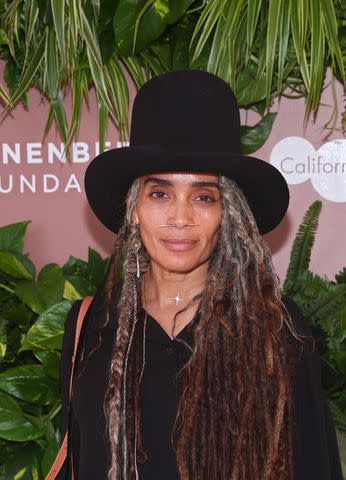Does Pulling Gray Hair Cause More? Experts Explain

Getty Images
Gray hair is bound to affect everyone at some point in life. For some, the loss of natural hair color starts in their early 20s (or sooner), while others don’t start going gray until well into middle age. Yet, no matter when your hair starts to turn more au naturel, one thing is for sure: pulling and plucking out gray and white strands isn’t the way to get rid of them.
Meet Our Expert
William Gaunitz, FWTS, is a certified trichologist and founder of Advanced Trichology.
Elyse Clark is a Pureology Educator and Chicago-based hairstylist.
Marisa Garshick, MD, is a board-certified dermatologist in New York.
For years, the hair debate has existed: does pulling gray hair cause more of them in their place? We turned to three experts to find out. Plus, got their expert tips on what to do if sporting your natural gray isn't your thing. The answer may surprise you.
Why Hair Turns Gray

Getty Images
Hair isn’t immune to aging, and even though it is considered dead once it makes its way out of the follicle, it is the follicle itself that contains pigment and the ability to give hair its natural coloration. Dr. Garshick explains that when hair turns gray, also known as canities or achromotrichia, it is because of a loss of melanin, which can occur with aging and may be partly related to genetics or environmental factors. “As we age, hair follicles may produce less melanin, so the hair that grows out is without pigment and appears white or gray,” she adds. However, when gray hair happens at a much younger age, it can be a genetic mutation or an underlying symptom of a health or medical issue. “Stress, nutritional deficiency, digestive problems, and inflammation will decrease the overall volume of melanocytes more quickly and lead to early-onset graying,” Gaunitz adds.
Once the follicles produce less melanin (the substance that gives hair and skin its color), the result shows on the hair. The natural decrease of melanin production doesn’t happen overnight, even though it may seem like it does, and it can take anywhere from a few months to years for a single follicle to produce less melanin. Eventually, when a cluster of follicles stops producing melanin, there’s more of an all-over gray effect, resulting in shades of gray and even white hairs.
Reasons Not to Pluck Out Gray Hairs
The urge to pull out gray hair can be tempting, but there is more than one reason to take a hands-off approach. While Dr. Garshick says pulling out gray hair won't cause more to grow in its place, she also shares that it is not a definitive treatment. "It won't permanently eliminate the gray hair, as the hair still has the potential to grow back. Plus, pulling them out can cause trauma to the hair follicle and potentially induce hair loss and scalp infections."
The more gray hairs you pluck from a single spot, the thinner the hair will look. And if you have a habit of doing this repeatedly, you can stunt the hair's regular growth patterns. Gaunitz says always resist plucking out gray hairs because it can create high levels of inflammation, mutate hair follicles, and reduce the volume of hair growing out of a single follicle.
Even if you can't fight the desire to yank a rogue gray hair, its absence will only be short-term. As soon as the hair is uprooted from its follicle, the growth cycle starts again. Then, it is only a matter of time before a new gray hair emerges in the same spot. Yet, as Clark explains, if you continuously pull out the same gray hair repeatedly, you risk damaging the follicle and preventing it from ever growing back. Over time, this can lead to thinning and bald patches with more concentrated gray hairs.
How to Manage Grays

Getty Images
There is no way to entirely prevent hair from turning gray, but Clark says there are ways to slow it down. "Gray hair largely depends on genetics. Stress is also a significant factor in advancing the loss of melanin from oxidative stress on the body. So, manage stress in your mind, body, and spirit to preserve your natural melanin as long as possible."
Hands down, the best way to cover up unwanted grays is with hair dye and temporary root concealers, which work in a pinch. "Multiple shades are available to match your color best," Clark says. "Root concealers are available as sprays, wands, sponges, or with a brush applicator. Choose whichever is best for the area of coverage needed." Our favorites include Tarte Big Ego Dab & Go Hair Concealer ($26), Style Edit Root Concealer Touch-Up Spray ($30), and ColorWow Root Coverup Powder ($35).
Another way to keep gray hair at bay is to eat a diet rich in vitamins and minerals, including biotin, zinc, copper, selenium, vitamins D3 and B12, omega-3 fatty acids, and more, which can help decelerate the rate of graying. "One study suggested that maintaining a normal weight, proper diet, and reducing alcohol consumption may help prevent graying," Dr. Garshick says. Similarly, smoking is linked to premature graying, as the added oxidative stress may contribute to graying.
Oral anti-gray supplements that preserve the hair's natural pigment, like VEGAMOUR Gro Ageless Gray Delay Hair Supplement ($78) and Arey Not Today Grey ($45), can also be helpful. "Topical solutions, which contains palmitoyl tetrapeptide 20, a biopeptide of the alpha-melanocyte-stimulating hormone, are another option," she says.
Of course, there’s always the option of embracing your grays and not fighting nature. With gray hair trending, it's easier than ever to ensure it enhances your features and flatters your overall appearance.
For more InStyle news, make sure to sign up for our newsletter!
Read the original article on InStyle.

